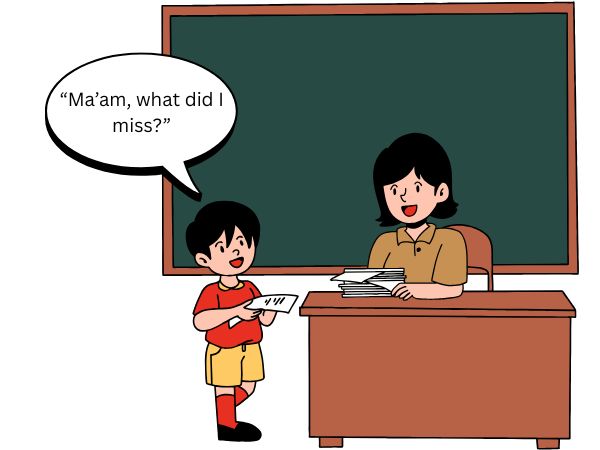I want to tell you about Rohan, a conscientious student in my Grade 10 class. One morning, he walked in looking utterly defeated. He’d missed the previous two days with a fever, and he approached my desk with the familiar, weary question: “Ma’am, what did I miss?”

I opened my planner. In his absence, we had:
Read Chapter 4 of the history text.
Completed a guided analysis of two primary sources.
Written a short paragraph connecting the chapter to a previous topic.
Started working on a timeline in pairs.
That was four assignments, but really, it was a dozen smaller tasks. I began explaining them, one after the other. “So first, you need to read the chapter and make notes on the key figures. Then, there are two documents you have to analyze using the ‘SEE’ method we learned—remember? After that, the paragraph needs to connect to the Mughal administration we discussed last week, and finally, you’ll have to find a partner to…”
I looked up. Rohan’s eyes were wide, but they weren’t seeing me. They were glazed over with a quiet panic. He was nodding mechanically, but I could see the mental shutters coming down. I was handing him an overstuffed backpack and telling him to run a marathon, and he was already tired.
I stopped. I took a breath.
“Rohan,” I said, closing my planner. “Forget all that for a second. Our main goal for this whole unit is simple: Understand why the East India Company shifted from trader to ruler. Everything we do is about that.”
His eyes flickered back to me.
“So, for you, right now, there is only one thing to do. Just read the chapter. Don’t even take notes yet. Just read it with that one question in mind: What gave the Company so much power? Come back and tell me one thing you discovered.”
The relief was palpable. The panic vanished, replaced by focus. He had a single, manageable rock to carry, not a landslide of gravel.
This is the reality of working memory—the mental workspace where students hold and manipulate information right now. It’s not about how smart they are; it’s about the fundamental cognitive limit we all share. George Miller called it the “Magical Number Seven, Plus or Minus Two,” but for a stressed student like Rohan, that number can shrink to three, or even one.
When we front-load instructions, list ten missed assignments, or explain a complex project all at once, we aren’t filling a vessel; we are overloading a circuit. The system simply bluescreens. The information, no matter how important, spills out and is lost.
As teachers, our most crucial job isn’t just to deliver content; it’s to be the architects of our students’ cognitive load. We must:
Chunk It: Break down units into core concepts, not just lists of tasks.
Simplify It: Identify the single, most important takeaway for this lesson, this hour.
Sequence It: Provide information like stepping stones across a river—one secure foothold at a time.
Rohan didn’t need the whole firehose. He just needed a single, clear glass of water. By respecting the limits of his working memory, I didn’t just give him back his confidence; I finally allowed the learning to begin.
Summary
The story illustrates the critical concept of working memory—the mind’s limited “workspace” for holding and processing immediate information. Through the example of a student, Rohan, who is overwhelmed by a list of missed assignments, we see how overloading this cognitive space causes anxiety and shutdown. The teacher realizes that delivering all the information at once is like overstuffing a backpack, making it impossible for the student to move forward. By shifting from a long list of tasks to a single, core concept, the teacher alleviates the cognitive load, restores the student’s focus, and enables true learning to begin.
Three Key Takeaways for Teachers
Working Memory is a Finite Resource, Not a Measure of Intelligence.
A student’s confused or glazed-over look is often a sign of cognitive overload, not a lack of effort or ability. Like a computer with too many programs running, their mental workspace has frozen. Recognizing this allows us to respond with support instead of frustration.Chunk Information into a Single, Core Concept.
The most effective way to prevent overload is to simplify and prioritize. Instead of listing every micro-task, anchor your instruction to one central question or goal for the lesson. As the story shows, replacing a list of ten things with one powerful question (“What gave the Company so much power?”) clears the mental clutter and directs energy toward learning.Be the Architect of Cognitive Load, Not Just a Deliverer of Content.
Our role extends beyond transmitting information; we must carefully design how that information is presented. By strategically sequencing tasks and releasing instructions one step at a time, we build secure stepping stones for students to cross the river of complexity, ensuring they don’t get swept away by the current of too much information at once.
 About the Author
About the Author
Vishwanathan Jayaraman is the Founder & CEO of Pipal Tree, a Neural Educator, researcher, and author of the best-selling book Brain-Based Teaching. He has trained over 50,000 teachers and reached more than 2 lakh students worldwide. His work focuses on bridging neuroscience and education to create classrooms that think, feel, and thrive.
Want to transform your school too? Bring the power of new-age teaching & learning.
Contact us to revolutionize your school’s teaching approach today!
In service since: 2010.
